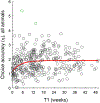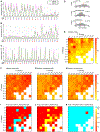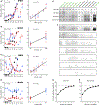The representation of decision variables in orbitofrontal cortex is longitudinally stable
- PMID: 39331504
- PMCID: PMC11549877
- DOI: 10.1016/j.celrep.2024.114772
The representation of decision variables in orbitofrontal cortex is longitudinally stable
Abstract
The computation and comparison of subjective values underlying economic choices rely on the orbitofrontal cortex (OFC). In this area, distinct groups of neurons encode the value of individual options, the binary choice outcome, and the chosen value. These variables capture both the choice input and the choice output, suggesting that the cell groups found in the OFC constitute the building blocks of a decision circuit. Here, we show that this neural circuit is longitudinally stable. Using two-photon calcium imaging, we record from the OFC of mice engaged in a juice-choice task. Imaging of individual cells continues for up to 40 weeks. For each cell and each session pair, we compare activity profiles using cosine similarity, and we assess whether the neuron encodes the same variable in both sessions. We find a high degree of stability and a modest representational drift. Quantitative estimates indicate that this drift would not randomize the circuit within the animal's lifetime.
Keywords: Neuroscience; calcium imaging; decision circuit; decision making; economic choice; longitudinal stability; orbitofrontal cortex; representational drift; subjective value; two-photon microscopy.
Copyright © 2024 The Author(s). Published by Elsevier Inc. All rights reserved.
Conflict of interest statement
Declaration of interests The authors declare no competing interests.
Figures







Update of
-
The Representation of Decision Variables in Orbitofrontal Cortex is Longitudinally Stable.bioRxiv [Preprint]. 2024 Feb 21:2024.02.16.580715. doi: 10.1101/2024.02.16.580715. bioRxiv. 2024. Update in: Cell Rep. 2024 Oct 22;43(10):114772. doi: 10.1016/j.celrep.2024.114772. PMID: 38712111 Free PMC article. Updated. Preprint.
Similar articles
-
The Representation of Decision Variables in Orbitofrontal Cortex is Longitudinally Stable.bioRxiv [Preprint]. 2024 Feb 21:2024.02.16.580715. doi: 10.1101/2024.02.16.580715. bioRxiv. 2024. Update in: Cell Rep. 2024 Oct 22;43(10):114772. doi: 10.1016/j.celrep.2024.114772. PMID: 38712111 Free PMC article. Updated. Preprint.
-
Economic Choices under Simultaneous or Sequential Offers Rely on the Same Neural Circuit.J Neurosci. 2022 Jan 5;42(1):33-43. doi: 10.1523/JNEUROSCI.1265-21.2021. Epub 2021 Nov 11. J Neurosci. 2022. PMID: 34764156 Free PMC article.
-
Partial Adaptation to the Value Range in the Macaque Orbitofrontal Cortex.J Neurosci. 2019 May 1;39(18):3498-3513. doi: 10.1523/JNEUROSCI.2279-18.2019. Epub 2019 Mar 4. J Neurosci. 2019. PMID: 30833513 Free PMC article.
-
Orbitofrontal Cortex: A Neural Circuit for Economic Decisions.Neuron. 2017 Nov 15;96(4):736-754. doi: 10.1016/j.neuron.2017.09.031. Neuron. 2017. PMID: 29144973 Free PMC article. Review.
-
Orbitofrontal cortex and the computation of economic value.Ann N Y Acad Sci. 2007 Dec;1121:232-53. doi: 10.1196/annals.1401.011. Epub 2007 Aug 14. Ann N Y Acad Sci. 2007. PMID: 17698992 Review.
Cited by
-
A Neural Circuit Framework for Economic Choice: From Building Blocks of Valuation to Compositionality in Multitasking.bioRxiv [Preprint]. 2025 Mar 13:2025.03.13.643098. doi: 10.1101/2025.03.13.643098. bioRxiv. 2025. PMID: 40161610 Free PMC article. Preprint.
References
-
- Gardner MPH, Sanchez D, Conroy JC, Wikenheiser AM, Zhou J, and Schoenbaum G (2020). Processing in lateral orbitofrontal cortex is required to estimate subjective preference during initial, but not established, economic choice. Neuron 108, 526–537.e4. 10.1016/j.neuron.2020.08.010. - DOI - PMC - PubMed
Publication types
MeSH terms
Substances
Grants and funding
LinkOut - more resources
Full Text Sources
Molecular Biology Databases

